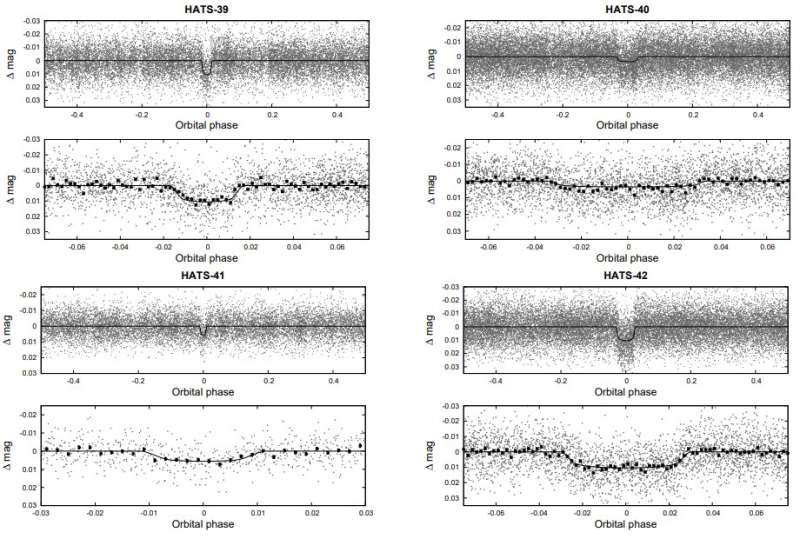April 10, 2018 report
Four new 'hot Jupiter' exoplanets discovered

Four new "hot Jupiter" extrasolar planets have been detected as part of the Hungarian-made Automated Telescope Network-South (HATSouth) exoplanet survey. The newly found alien worlds are generally similar in size, but vary widely in mass. The discovery is detailed in a paper published April 4 on the arXiv pre-print server.
HATSouth is a network of six astrograph telescope systems located in South America, Africa, and Australia. These telescopes are designed to detect transiting extrasolar planets in orbit around relatively bright stars visible from the Southern hemisphere. Since its launch in 2009, the network has already detected dozens of transiting exoplanets.
Now, a team of astronomers led by Joao Bento of the Australian National University (ANU), reports the finding of another exoplanets using HATSouth telescopes. They found transit signals in four stars, namely: HATS-39, HATS-40, HATS-41 and HATS-42. Afterward, the planetary nature of these signals was confirmed by follow-up photometric and spectroscopic observations.
"In this paper we report the discovery and characterisation of four new transiting hot Jupiters from the HATSouth survey: HATS-39b, HATS-40b, HATS-41b and HATS-42b," the researchers wrote in the paper.
All four newly detected planets transit moderately bright dwarf stars of F-type and were classified as "hot Jupiters." Such extrasolar worlds are similar in characteristics to the solar system's biggest planet, with orbital periods of less than 10 days. They have high surface temperatures as they orbit their parent stars very closely.
With a mass of 0.63 Jupiter masses, HATS-39b is the least massive exoplanet of the newly found quartet. However, its radius—about 1.57 Jupiter radii—is larger than it should be, thus the researchers describe HATS-39b as an inflated planet. The exoworld orbits its host every 4.58 days at a distance of 0.06 AU, and its equilibrium temperature is 1,645 K.
HATS-40b is approximately 58.5 percent more larger and massive than Jupiter. It takes the planet about 3.26 days to fully orbit its parent star as it is separated from the host by 0.05 AU. The equilibrium temperature of this alien world is estimated to be around 2,100 K.
HATS-41b is the most interesting exoplanet reported in the paper. It is only 33 percent larger than Jupiter, but nearly 10 times more massive than our solar system's biggest planet. According to the researchers, it is one of the most massive "hot Jupiters" found to date and orbits the highest metallicity star to host a transiting planet. HATS-41b has an orbital period of 4.19 days, is located about 0.06 AU from the host, and has equilibrium temperature of 1,710 K.
When it comes to HATS-42b, it has a radius of 1.4 Jupiter radii and a mass of 1.88 Jupiter masses. It is separated from HATS-42 by approximately 0.037 AU and fully orbits it in 2.29 days. The equilibrium temperature of this planet is 1,856 K.
More information: HATS-39b, HATS-40b, HATS-41b, and HATS-42b: Three Inflated Hot Jupiters and a Super-Jupiter Transiting F Stars, arXiv:1804.01623 [astro-ph.EP] arxiv.org/abs/1804.01623
J Bento et al. HATS-39b, HATS-40b, HATS-41b, AND HATS-42b: THREE INFLATED HOT JUPITERS AND A SUPER-JUPITER TRANSITING F STARS, Monthly Notices of the Royal Astronomical Society (2018). DOI: 10.1093/mnras/sty726
Abstract
We report the discovery of four transiting hot Jupiters from the HATSouth survey: HATS-39b, HATS-40b, HATS41b and HATS-42b. These discoveries add to the growing number of transiting planets orbiting moderately bright (12.5 < V < 13.7) F dwarf stars on short (2-5 day) periods. The planets have similar radii, ranging from 1.33(+0.29/-0.20) R_J for HATS-41b to 1.58(+0.16/-0.12) R_J for HATS-40b. Their masses and bulk densities, however, span more than an order of magnitude. HATS-39b has a mass of 0.63 +/- 0.13 M_J, and an inflated radius of 1.57 +/- 0.12 R_J, making it a good target for future transmission spectroscopic studies. HATS-41b is a very massive 9.7 +/- 1.6 M_J planet and one of only a few hot Jupiters found to date with a mass over 5 M_J. This planet orbits the highest metallicity star ([Fe/H] = 0.470 +/- 0.010) known to host a transiting planet and is also likely on an eccentric orbit. The high mass, coupled with a relatively young age (1.34 +0.31/-0.51 Gyr) for the host star, are factors that may explain why this planet's orbit has not yet circularised.
Journal information: Monthly Notices of the Royal Astronomical Society
© 2018 Phys.org





















